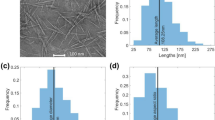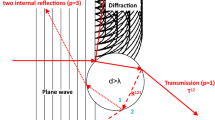Abstract
A new apparatus for flow visualization based on Polarization Imaging Method (PIM) is developed. In this method, the polarization imaging camera, which is composed of a photonic crystal and CCD image sensor, is used to measure anisotropy of refractive index tensor. The photonic crystal placed in the front of CCD image sensor works as an assembly of analyzer plates for each of photo detectors of the image sensor, which provides four polarization components of image. By analysis of the polarization imaging data, the spatial distribution of birefringence and extinction angle can be obtained simultaneously. Since birefringence and extinction angle have strong relationship with stress and orientation angle due to Stress-Optical Rule (SOR), their distribution is appropriate to understand non-uniform flow. The advantage of the apparatus was examined by imaging flow of wormlike micellar solution in uniform and non-uniform shear flows. In the uniform shear rate geometry of cone and plate, we successfully obtained spatial distribution of birefringence and extinction angle of flow-induced structure of threadlike micelles.













Similar content being viewed by others
References
Berret JF (1997) Transient rheology of wormlike micelles. Langmuir 13:2227–2234
Britton MM, Callaghan PT (1999) Shear banding instability in wormlike micellar solutions. Eur Phys J B 7:237–249. doi:10.1007/s100510050610
Casanellas L, Dimitriou CJ, Ober TJ, McKinley GH (2015) Spatiotemporal dynamics of multiple shear-banding events for viscoelastic micellar fluids in cone-plate shearing flows. J Non-Newtonian Fluid Mech 222:234–247. doi:10.1016/j.jnnfm.2014.12.005
Decruppe J, Greffier O, Manneville S, Lerouge S (2006) Local velocity measurements in heterogeneous and time-dependent flows of a micellar solution. Phys Rev E 73:061509
Fielding SM, Olmsted PD (2004) Spatiotemporal oscillations and rheochaos in a simple model of shear banding. Phys Rev Lett 92:084502
Fischer P, Wheeler EK, Fuller GG (2002) Shear-banding structure orientated in the vorticity direction observed for equimolar micellar solution. Rheol Acta 41:35–44
Fukushima E (1999) Nuclear magnetic resonance as a tool to study flow. Annu Rev Fluid Mech 31:95–123. doi:10.1146/annurev.fluid.31.1.95
Fuller GG (1995) Optical rheometry of complex fluids. Oxford University Press, New York
Ganapathy R, Sood A (2006) Tuning rheochaos by temperature in wormlike micelles. Langmuir 22:11016–11021
Hanlon AD, Gibbs SJ, Hall LD, Haycock DE, Frith WJ, Ablett S (1998) Rapid MRI and velocimetry of cylindrical Couette flow. Magn Reson Imaging 16:953–961. doi:10.1016/S0730-725x(98)00089-7
Hayward RJ, Tomlinso DJ, Packer KJ (1972) Pulsed field-gradient spin-echo NMR studies of flow in fluids. Mol Phys 23:1083. doi:10.1080/00268977200101061
Herle V, Kohlbrecher J, Pfister B, Fischer P, Windhab EJ (2007) Alternating vorticity bands in a solution of wormlike micelles. Phys Rev Lett 99:158302
Hu Y, Boltenhagen P, Pine D (1998) Shear thickening in low-concentration solutions of wormlike micelles. I. Direct visualization of transient behavior and phase transitions. J Rheol (1978-present) 42:1185–1208
Humbert C, Decruppe JP (1998) Flow birefringence and stress optical law of viscoelastic solutions of cationic surfactants and sodium salicylate. Eur Phys J B 6:511–518. doi:10.1007/s100510050578
Inoue T, Nakatsuji R, Watanabe H, Tsujii Y (2008) Effect of surface treatments on viscoelastic measurements of thread-like micellar solutions. Nihon Reoroji Gakkaishi 36:187–190
Janeschitz-Kriegl H (1983) Polymer melt rheology and flow birefringence. Springer-Verlag, Berlin
Lerouge S, Berret J-F (2009) Shear induced transitions and instabilities in surfactant wormlike micelles. Springer-Verlag, Berlin Heidelberg
Manneville S (2008) Recent experimental probes of shear banding. Rheol Acta 47:301–318. doi:10.1007/s00397-007-0246-z
Ober TJ, Soulages J, McKinley GH (2011) Spatially resolved quantitative rheo-optics of complex fluids in a microfluidic device. J Rheol 55:1127–1159. doi:10.1122/1.3606593
Onuma T, Otani Y (2014) A development of two-dimensional birefringence distribution measurement system with a sampling rate of 1.3 MHz. Opt Commun 315:69–73. doi:10.1016/j.optcom.2013.10.086
Raudsepp A, Callaghan PT (2008) A rheo-optical study of shear rate and optical anisotropy in wormlike micelles solutions. Soft Matter 4:784–796. doi:10.1039/b713416a
Sedney R (1972) Visualization of boundary-layer flow patterns around proturberances using an optical-surface indicator. Technique Phys Fluids 15:2439–2441. doi:10.1063/1.1693890
Sedney R, Kitchens CW, Bush CC (1973) Marriage of optical, tracer, and surface indicator techniques in flow visualization. Survey IEEE T Aero Elec Sys Aes 9:823–823
Shikata T, Dahman SJ, Pearson DS (1994) Rheo-optical behavior of wormlike micelles. Langmuir 10:3470
Wheeler EK, Fischer P, Fuller GG (1998) Time-periodic flow induced structures and instabilities in a viscoelastic surfactant solution. J Non-Newtonian Fluid Mech 75:193–208
Acknowledgments
This research was partially supported by a Grant-in-Aid (24350120 and 16H04204) from the ministry of Education, Culture, Sports, Science and Technology, Japan.
Author information
Authors and Affiliations
Corresponding author
Appendix
Appendix
Correction method for blur of polarizer array
In order to correct blur of polarizer array, we considered expansion of each transmitted light at the front of each detector as shown in Fig. 2. For such a case, the measured intensity of I(i,j) at position (i,j) could be smeared with the leaked light from the adjacent polarizing plates such as (i ± 1, j ± 1). Let us suppose that the true light intensity, I'(i,j), representing the intensity of light just after passing through the polarizer. We further assume that this light is uniformly expanded from 1 to 1 + 2a in ratio in both x and y directions in the front of each detector. The smeared intensity, I', can be related to the true intensities, I', as follows
By using Eq. (16), we obtain
If the pixel size is enough small to the overall image, then the gradient of light could be negligibly small. For such a case, we can assume
Thus, we obtain
This indicates that J(n,m,1) can be related to Jʹ(n,m,k). Similar equations can be derived for other k = 2, 3, and 4. Thus, we obtain
The desmeared intensity, J′(n,m), can be evaluated from J(n,m) by solving the above simultaneous equations, J′(n,m) = A –1 J(n,m). For our PIC, a was found to be 0.0692.
Rights and permissions
About this article
Cite this article
Oba, N., Inoue, T. An apparatus for birefringence and extinction angle distributions measurements in cone and plate geometry by polarization imaging method. Rheol Acta 55, 699–708 (2016). https://doi.org/10.1007/s00397-016-0952-5
Received:
Revised:
Accepted:
Published:
Issue Date:
DOI: https://doi.org/10.1007/s00397-016-0952-5




